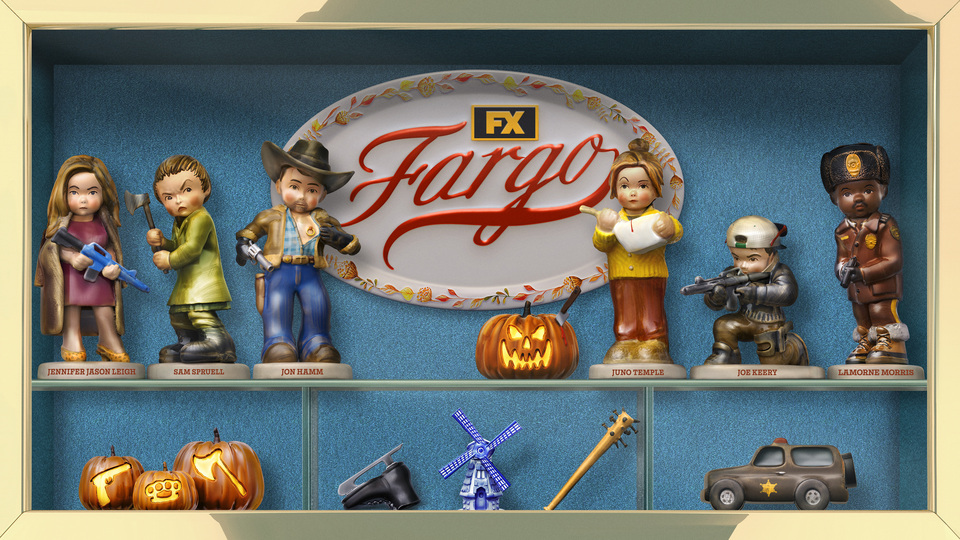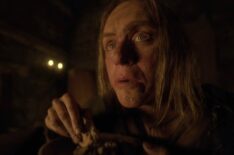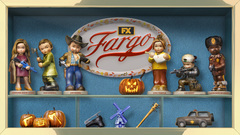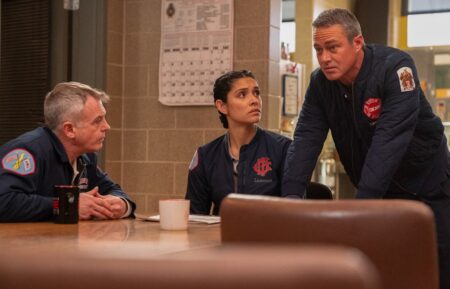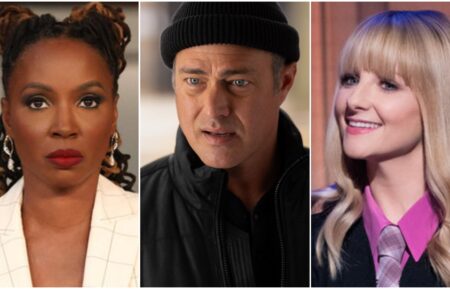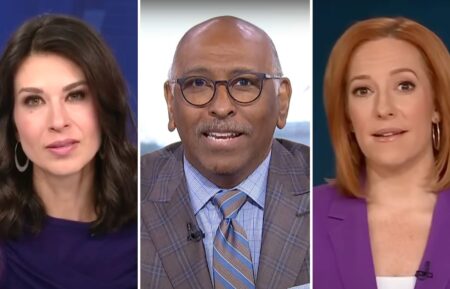‘Fargo’ Star David Rysdahl Breaks Down the Lyon Family’s Fiery House of Horrors
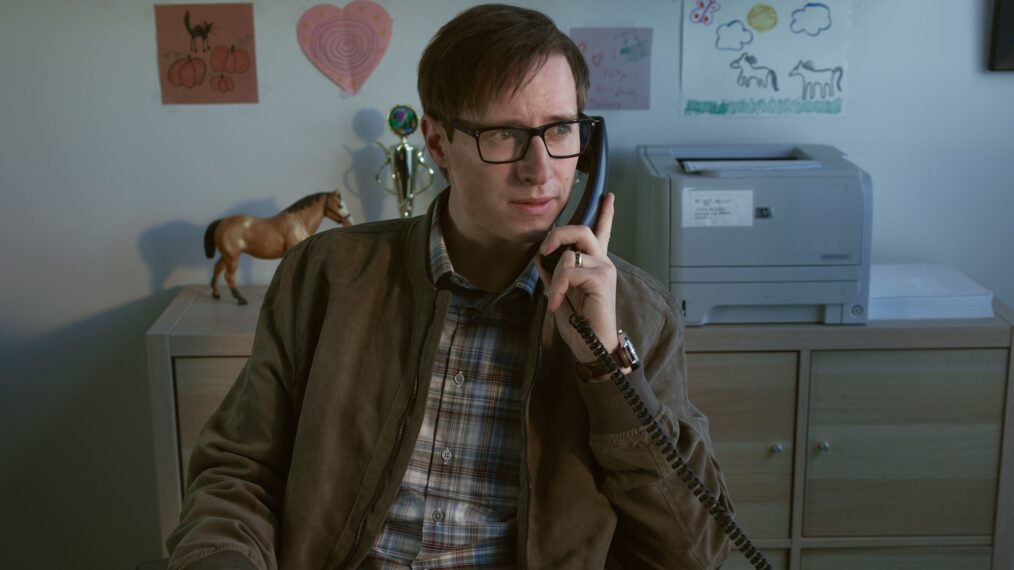
Spoiler Alert
[Warning: The below contains MAJOR spoilers for Fargo Year 5 Episode 4, “Insolubilia.”]
Fargo‘s fifth year took a terrifying turn for Dot (Juno Temple) and her family in Episode 4, “Insolubilia,” as Gator (Joe Keery) the son of her possessive former husband Roy (Jon Hamm), broke in with intentions to kidnap her. The Halloween-timed scheme unfolds in her booby-trapped home while her husband Wayne (David Rysdahl) and daughter Scotty (Sienna King) take temporary refuge in the attic of their home until their hideaway is uncovered.
While Dot takes on the kidnappers single-handedly for the first half of the break-in, soon the whole family is involved as Wayne listens to her instructions but begs for answers as to why this mystery man is calling his wife “Nadine.” Once the immediate threats are neutralized, Dot tells her family to escape down the laundry shoot, but Wayne opts for the trellis out his and Dot’s bedroom window, forgetting that she’s rigged the windows with electrified wire.
Before she’s able to stop him, Wayne is zapped, setting sparks off that light their curtains on fire. As he lies unconscious on the floor, Dot barricades her and Scotty into the room, pulls the curtains away from the window, and works on getting the whole family out of the only exit. The mother and daughter manage to get a limp Wayne out the window and onto the roof, and as Scotty dashes down the trellis, Dot deals with getting her and Wayne to safety as the life she’s built for herself burns to the ground before her eyes.
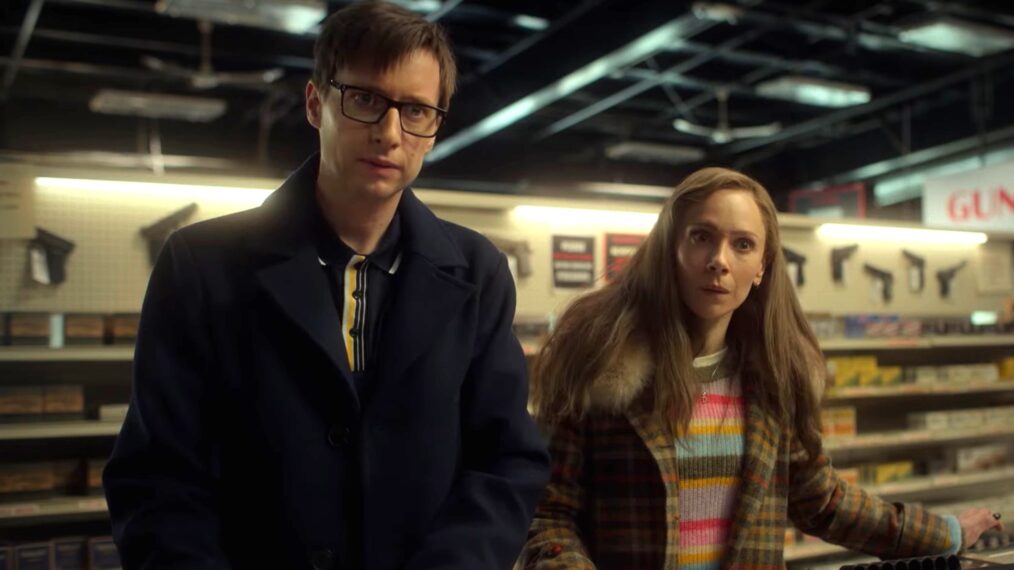
FX
Although Wayne seems worse for wear, he does pull through, waking up in the hospital a little confused with damaged hands. Dot attempts to hide the truth of the situation when she’s questioned by Witt Farr (Lamorne Morris) and Indira Olmstead (Richa Moorjani), but selling her version of events to a confused Wayne proves a little tougher as he initially calls her Nadine, hinting at buried questions.
Below, Rysdahl opens up about Wayne’s wacky Halloween night and what’s next for the car salesman, father, and husband as Dot’s lies begin to impact her family directly.
What was it like filming the break-in, and did you come up with a story for what led Wayne to the attic?
David Rysdahl: It’s a good point of view of what happens between that last moment in Episode 3 [and the start of Episode 4]. From Wayne’s point of view, I’m in the attic and I’m like, “How did I get to the attic?” And Juno, Sienna, and I were talking with the director, and we’re like, well, I think [Dot] was like, ‘You have to go to the attic.’ And [Wayne’s] just trying to be understanding and supportive of her. [But he thinks] she’s maybe going through a mental breakdown. [So Wayne goes up to the attic] and makes it a game for Scotty. And then suddenly [Wayne] starts hearing things downstairs and I’m like, ‘What is she doing?’
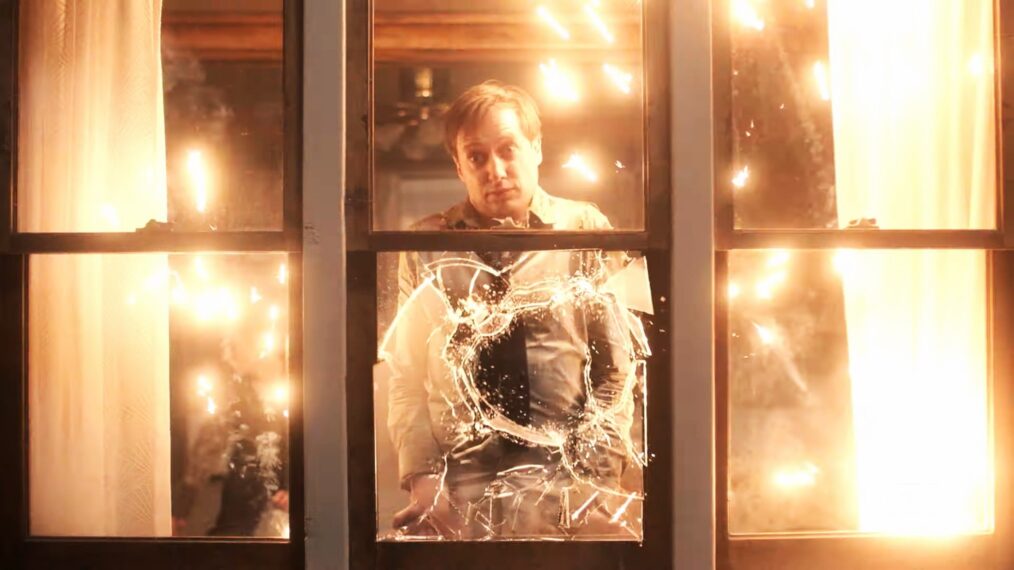
(Credit: FX)
Then Wayne gets sucked into the hurricane of it. But for me, I always try to connect those dots. Wayne has no idea what’s going on. So you just kind of play into that. Once I come back into the scene, you of course choreograph it to try to make sure everyone’s safe, but you just kind of play in this sense of, I have no idea what’s going to happen. So it’s a perfect place to be as an actor.
How did the filming process work? On set, we saw the first floor. Was the second floor attached to the same set?
There were three houses. There’s an upper-level house that’s just like the upper level, [and] that [ground] level you saw goes up, but it pretty much stops once you get to the top [of the stairs]. And then there’s an exterior. The upper level is its own house, so they can be working on all three sets at one time. And also it’s easier to do some of those stunts if they’re closer on the ground. But it was interesting. You have to remember what was happening right before [the point you were filming] in the other houses. So then I can make sure it has emotional continuity and makes sense.
Once Wayne is electrocuted, you are dragged around by Juno, and thrown from a roof. What was the stunt work like for those sequences?
Juno Temple is much stronger than you would imagine. She’s a little person, but she’s so strong and I was very impressed with how much she could hold. But there was a little bit of back-scene magic and a little tightening of my core helping to get up [to the window] without the camera seeing so that it looks right. It seems like it’d be easy, but it is hard to pretend that you’re unconscious because your initial impulse is to protect yourself. So I think I talked through that with the stunt people a lot. And then they did the fall off the house — that wasn’t me — but I did a five-foot fall off and then they did the 15-foot landing, for insurance reasons. But they had such a good stunt team up there. They’re all rodeo people. In the off-season when they’re not on stunts, they’re riding bucking broncos and stuff. It’s pretty amazing. So for them, it’s light work, I think. But for us, it’s fun to do it.
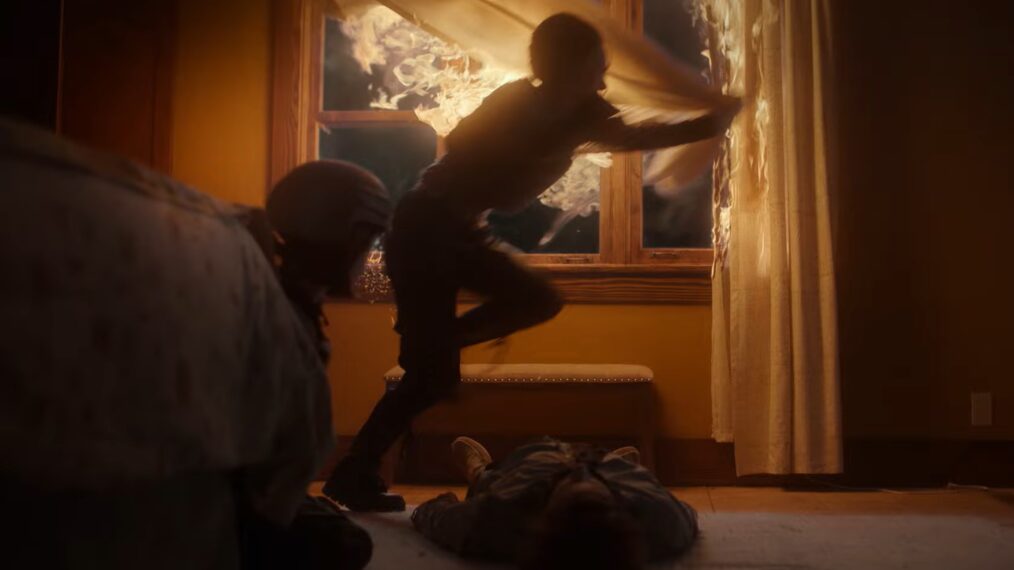
(Credit: FX)
How did the electrocution work? Was it practical, or was there CGI involved?
All those sparks are happening in real life; that’s not CGI, that’s all happening onscreen. All of the curtains are flyway curtains, so if you get a spark on them, they start to sizzle and go crazy. The first time we did that, they fizzled way too fast. There’s a whole team just on pyrotechnics, and there’s a team that’s doing the choreography, so you want everyone to feel safe. And then you also have this little nine-year-old actor and you don’t want her to be scared, but she’s also scared in the scene, so there were a lot of moving parts.
Then when you hit that shot, when I touched [the windowsill] and the sparks all fly off, of course, I’m not getting electrocuted, but I’m pretending I am, and then it starts to burn the right way, and [I] fall backward. It feels like team sports. You’re all trying for this one moment to happen. And then it happens and it’s like the best moment in film. There are moments that are very difficult, and then you capture it and you watch the replay and everyone’s congratulating each other. That took a couple of hours to get that right.
Obviously, Wayne’s memory is fuzzy after the entire ordeal. Do you think he remembers any part of that break-in? He seems to remember Dot’s other name, Nadine.
When I was approaching it, it’s kind of like a dream that you’ve had or maybe a night you’ve drank a little too much and you’re coming back. [There are] three episodes, I think, where his brain’s coming back. And not only is he coming back to understand [what’s happening], he’s understanding his whole life in a whole new way. You’re saying his wife, everything he thought about this woman he loves is not real. And so what is real? He’s questioning the reality of what life is, but also the reality that he had is different than his new reality. And for me, that’s a lot of the arc of Wayne. He starts this season perky, like life’s great, and then he is hit with the reality of what his life actually is, and some of this Minnesota nice caves in.
He has to choose, where does my relationship with my wife lie? And there’s a stillness to the later episodes for Wayne, of sitting in [the conflict] instead of just being peppy and aversive to conflict. This is difficult, and [he has] to sit in it, and that’s going to make [Wayne and Dot] stronger as a couple. He doesn’t know that, but he can’t just be positive, [he needs] to sit with it and deal with it. I think that’s a big theme of the season. Our past, our trauma, our debts are going to catch us, and we can’t just outrun them, and make a whole new identity out of them. We have to deal with these old debts that we owe. And for me, that’s what Wayne has to sit in as the season progresses and as his brain heals.
When it comes to the world of Fargo, big events like the house fire could change a character for the worse or better. How do you think Wayne will be changed?
Well, I think he’s a foil to not only Roy but also to Jerry Lundegaard from the original movie. And this idea of, if all humans are going to change for the worse, then who wants to live that life? And I think what’s profound about Fargo is there are really good people, too, and people can be the best version of themselves. I’ve played other characters who don’t make those choices, but in Wayne, I was like, oh, he faces the darkness and ends up becoming — I think — purer and his values go deeper and he becomes stronger. And that was important for Noah [Hawley] and myself to not make this guy a joke. Because, if you love your wife and you’re a joke, then what are we saying about masculinity?
He has to grow up. He’s lived this kind of idealistic life and has been afraid of controversy, of conflict, and he has to face the music. And what happens then? What’s the real character of Wayne? And I think he’s questioning that about himself. Who am I? If I don’t know who I am, who my wife is… Then let me grow into the person I want to be. And I think there’s a lot of positive growth in his arc.
Fargo, Year 5, Tuesdays, 10/9c, FX (Next day on Hulu)

